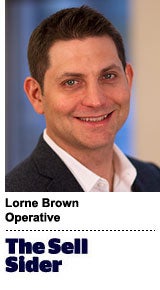 “The Sell Sider” is a column written for the sell side of the digital media community.
“The Sell Sider” is a column written for the sell side of the digital media community.
Today’s column is written by Lorne Brown, CEO at Operative.
New viewability measurement capabilities and the discovery of rampant fraud in ad exchanges has led advertisers to question whether any online advertising is actually seen by viewers.
As a result, buyers are clamoring for much stricter ad viewability standards. That includes GroupM and American Express, which both recently started pushing for a zero-tolerance viewability policy in which they only pay for ads that are 100% in view for several seconds.
This is obviously significantly stricter than anything a TV buyer has tried to enforce on media companies and is stricter than recommendations by third-party groups, such as the IAB. Such hair-on-fire talk creates a dangerous situation for premium publishers that have the most to lose and are the least guilty.
Most At Risk: Premium Content
The first issue with the 100% viewability standard is that it’s not even technically possible in most cases. The IAB recently reported that 70% is the best they could recommend based on the wild swings in reporting from different viewability vendors, which use anything from panel measurements to predictive algorithms to determine viewability. There are also a wide variety of types and technologies used by each publisher across display, video, mobile and social ad placements, making the idea that any kind of standard could be enforced more remote.
The second threat to premium publishers is that not only are many advertisers starting to refuse to pay for non-viewable ads, they are not willing to increase the CPM of the viewable ads. This is nonsense. If a campaign provided a certain value for an advertiser, then it is worth the price that they paid for it, regardless of the impressions that went unseen. Also, publishers set prices in a way that allows them to stay in business. If advertisers squeeze premium publishers hard enough, there won’t be any premium content to advertise against.
Publishers: Embrace Viewability And Shift To Quality
The reason buyers are getting all of the airtime with viewability is that publishers remain in “reaction” mode. Publishers have the most to lose in the short term, but their overall survival depends on doing the math for themselves and determining how they can embrace normal viewability standards.
Hulu’s Peter Naylor recently said that the company’s ability to embrace viewability and accept a realistic standard has actually increased its overall CPMs because it has had to deal with fewer make-goods while enjoying higher repeat buys. More premium publishers should take a proactive stance by eliminating their worst placements and not waiting around to see what advertisers put on RFPs. This is not just for short-term gain. Publishers that duck viewability will be lumped together with lower-quality inventory that can’t be trusted and they won’t be viewed as strategic partners.
That’s the point. Viewability is a big deal because advertisers can’t trust publishers. TV might have issues with most DVR owners skipping ads, as some studies suggest, but TV advertisers know that ad placements are all standard and there isn’t a lot of shady activity.
The digital side is not there yet. Premium publishers must approach viewability as part of a larger conversation about how they differentiate through quality, which also includes audience data, unique content and the design and context of the ad itself. If publishers created a “quality” plan for themselves and policed and priced their inventory accordingly, the alarm bells would stop sounding.
Follow Operative (@Operative) and AdExchanger (@adexchanger) on Twitter.










